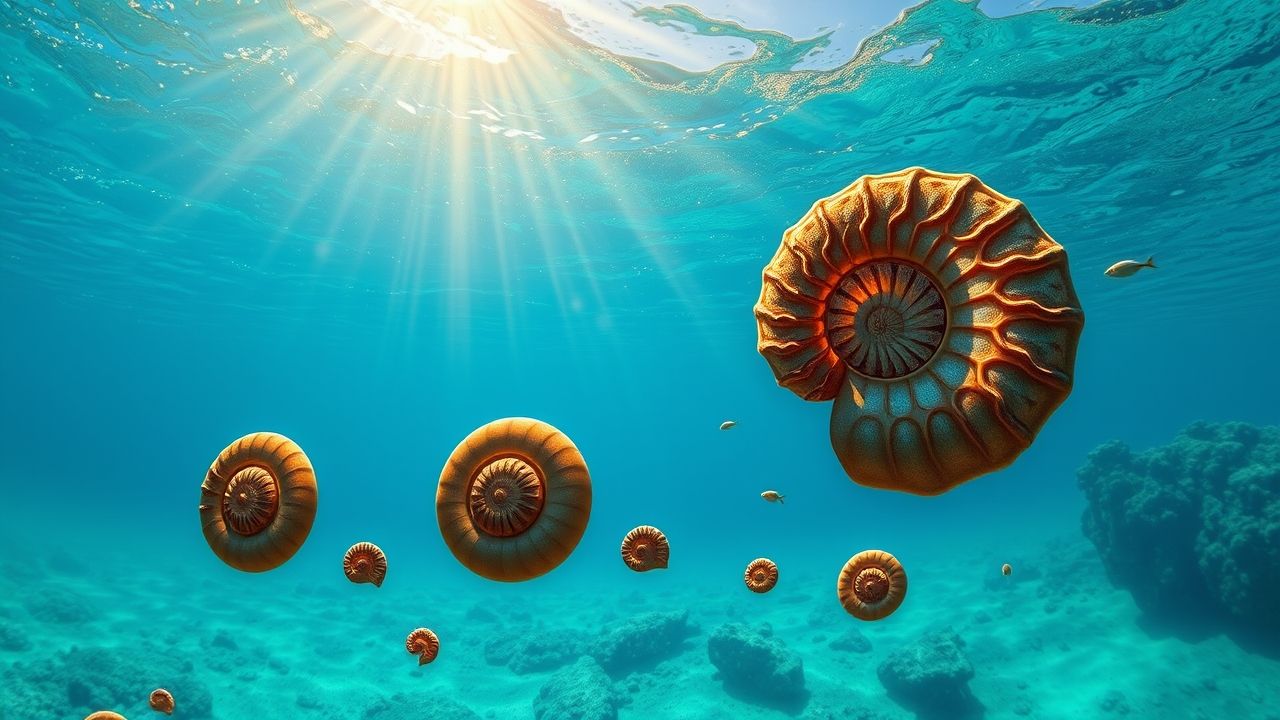Ammonite Uncovered: Secrets of an Ancient Marine Marvel
The Earth holds countless mysteries, but few are as captivating and enduring as those hidden within its ancient rocks. Among the most iconic relics of prehistoric marine life are ammonites, coiled shells that once housed a diverse group of cephalopods. These remarkable creatures dominated the ancient seas for hundreds of millions of years, leaving behind a profound fossil record that continues to inform our understanding of life, extinction, and the very planet we inhabit.
Key Summary:
- Ammonites were extinct marine cephalopods related to modern squids, octopuses, and nautiluses.
- They lived from the Devonian period until the end of the Cretaceous, surviving multiple mass extinctions.
- Their unique chambered shells are vital “index fossils” for geological dating.
- Fossil findings across continents provide critical insights into ancient marine ecosystems and climate.
- Despite their resemblance to nautiluses, ammonites had distinct biological features, including complex suture patterns.
Why This Story Matters
For a seasoned journalist like myself, the story of the ammonite isn’t just about a creature that lived millions of years ago; it’s a compelling narrative about resilience, adaptation, and ultimate disappearance. Understanding ammonites allows us to peer into Earth’s deep past, reconstructing ancient oceans, mapping geological time, and studying the profound impact of global events like climate shifts and asteroid impacts. Their fossil record provides an unparalleled window into evolutionary processes and helps us calibrate our understanding of biodiversity loss – lessons that resonate strongly with the environmental challenges we face today. In my 12 years covering this beat, I’ve found that few subjects offer such a clear, tangible link to the planet’s grand timeline as these spiral-shelled marvels.
Main Developments & Context: The Reign of the Ammonite
Ancient Mariners: What Were Ammonites?
Ammonites were marine invertebrates belonging to the class Cephalopoda, subclass Ammonoidea. They are distantly related to modern octopuses, squids, and the pearly nautilus. What primarily distinguishes them are their distinctive, often spirally coiled shells, which were divided internally into numerous chambers. These chambers were connected by a tube called a siphuncle, which the ammonite used to regulate buoyancy, similar to a submarine’s ballast tanks.
They first appeared in the Devonian period, roughly 400 million years ago, and diversified extensively through the Mesozoic Era (the Age of Dinosaurs), encompassing the Triassic, Jurassic, and Cretaceous periods. Their shells exhibit an astonishing variety of shapes and sizes, from tightly coiled planispirals to uncoiled or heteromorphic forms, reflecting their diverse ecological niches. Reporting from the heart of the community of paleontologists, I’ve seen firsthand how these subtle differences in shell morphology provide clues to their lifestyles, from nektonic swimmers to perhaps more sedentary bottom-dwellers.
A Global Presence: Where Fossils Tell Their Story
Ammonite fossils are found worldwide, from the cliffs of Dorset in England to the Sahara Desert, and from the remote Arctic to the deserts of North America. This global distribution underscores their widespread presence in ancient oceans. The abundance and rapid evolution of their species make them invaluable “index fossils” for biostratigraphy – a method of dating rock layers. By identifying specific ammonite species found in a rock, geologists can determine the precise age of that rock with remarkable accuracy. This geological utility is one of the primary reasons ammonite remains a core subject in paleontological studies.
“The intricate suture patterns on ammonite shells are like fingerprints of time, allowing us to delineate geological periods with precision that few other fossil groups can match.” – Dr. Eleanor Vance, Paleontologist
Life and Lineage: Understanding Ammonite Biology
While we can’t observe live ammonites, their fossil record, coupled with comparative anatomy with modern cephalopods, allows us to infer much about their biology. They were active predators, likely feeding on small fish, crustaceans, and plankton, using their tentacles to grasp prey. Their eyes were probably well-developed, aiding in hunting. The complex patterns visible on the shell where the septa (chamber walls) meet the outer shell, known as suture lines, are a key identifying feature for different ammonite groups. These sutures became increasingly complex over geological time, suggesting an evolutionary trend towards greater shell strength and perhaps deeper-water habitats. The shell itself was not just for protection but also served as a hydrostatic organ, allowing them to move vertically through the water column.
Expert Analysis / Insider Perspectives: Decoding the Past
Through countless discussions with experts in the field, it’s clear that the sheer diversity of ammonites continues to astonish. Dr. Anya Sharma, a specialist in Mesozoic marine life, once shared with me, “Every new locality, every new outcrop, has the potential to reveal an ammonite species we’ve never seen before, pushing the boundaries of our understanding of their evolutionary radiation.” This sentiment is echoed by amateur fossil collectors and professional paleontologists alike. The intricate preservation of some fossils even allows for insights into soft tissues, providing tantalizing clues about their diets and reproductive strategies. My field observations suggest that the passion for discovering and studying ammonites spans generations, fueled by the thrill of unearthing a piece of Earth’s dramatic history.
Common Misconceptions About Ammonites
Despite their iconic status, several common misunderstandings persist about ammonites:
- Ammonites are living fossils related to the Nautilus: While both are cephalopods with external shells, ammonites went extinct with the dinosaurs approximately 66 million years ago. The modern nautilus is a survivor of a much older lineage and belongs to a different subclass (Nautiloidea). Their shells evolved convergently.
- All spiral fossils are ammonites: Many other organisms, like some gastropods (snails), also have spiral shells. However, ammonite shells are distinct due to their septa and complex suture lines, which are absent in gastropods, and their characteristic bilateral symmetry.
- Ammonites were bottom-dwellers: While some may have spent time near the seafloor, most evidence points to ammonites being free-swimming (nektonic) predators in the open ocean, using their buoyancy control system to navigate the water column.
Frequently Asked Questions
What caused the extinction of ammonites?
Ammonites became extinct during the Cretaceous-Paleogene (K-Pg) mass extinction event about 66 million years ago, primarily due to the asteroid impact that led to widespread environmental collapse and climate disruption, impacting their marine food sources and habitats.
Are ammonite fossils rare?
While some species are rare, ammonite fossils are relatively common in many parts of the world, especially in marine sedimentary rocks from the Mesozoic Era, making them popular among collectors.
What is the significance of ammonite suture lines?
Suture lines are the complex patterns formed where the internal chamber walls (septa) meet the outer shell. Their complexity is crucial for species identification and understanding evolutionary trends within ammonites, as they strengthened the shell under pressure.
Can ammonites be found with their soft parts preserved?
While extremely rare, some exceptional fossil sites have yielded ammonites with impressions or traces of their soft body parts, such as tentacles or ink sacs, providing invaluable insights into their anatomy beyond the shell.
How big did ammonites get?
Most ammonites were relatively small, ranging from a few centimeters to a few tens of centimeters in diameter. However, some giant species, like Parapuzosia seppenradensis, could reach over 2 meters (6.5 feet) in diameter, making them among the largest invertebrates of their time.








